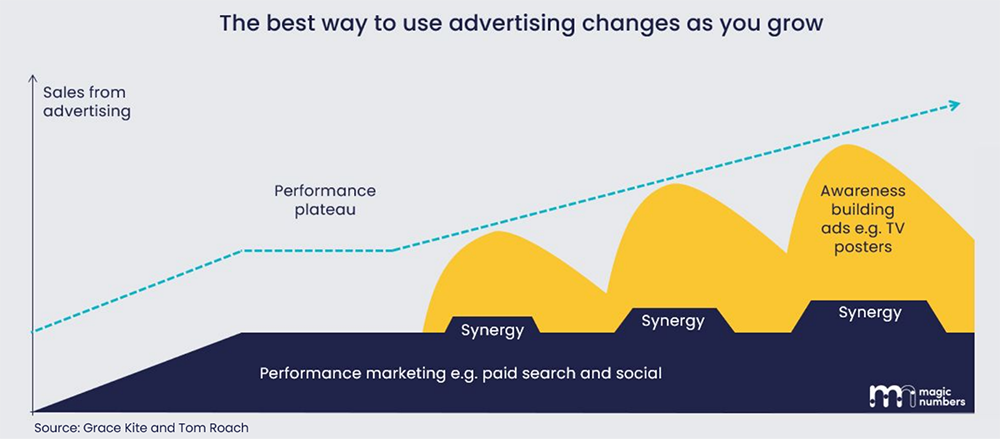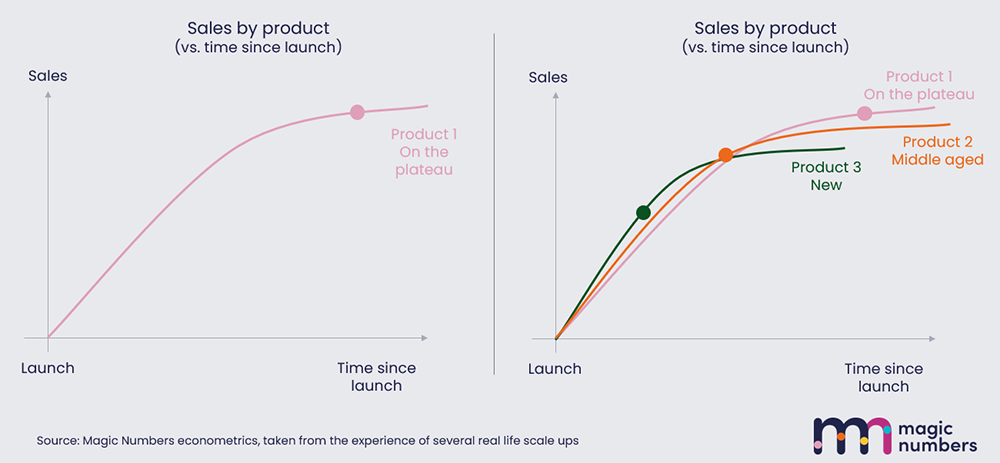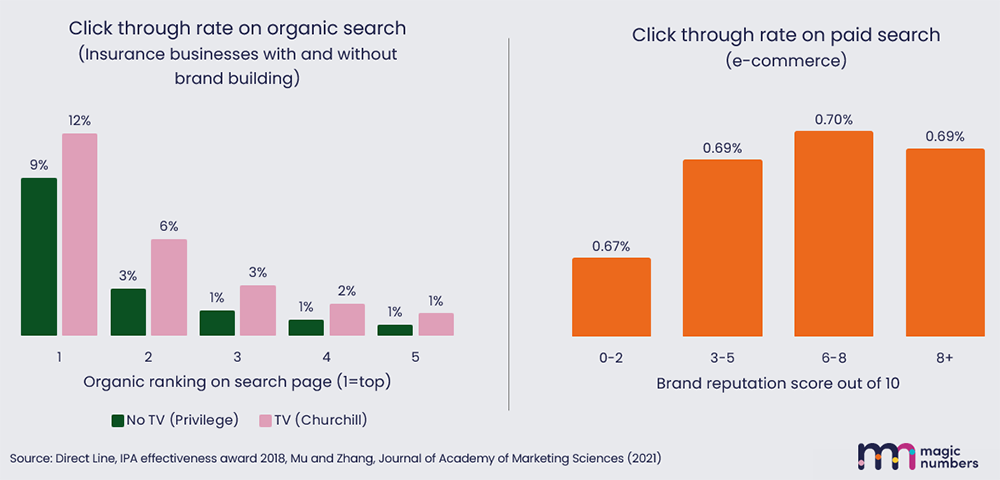A combination of brand building and performance marketing is the best approach, but putting this strategy into action is not always straightforward, especially for businesses established online. Magic Numbers’ Grace Kite and Andy Nethercott explain not only when to focus on brand marketing, but how to sell the investment to internal stakeholders.
There’s a reason why people are still talking about ‘The Long and The Short of It’ 10 years on. Why you still see marketing people clutching their weathered copy, now mottled by countless corner folds and coffee spots.
It’s because marketers still struggle to get their own mix of brand vs activation right. The theory is powerful, but it doesn’t change things on its own.
Putting theory into practice means combining it with your own data and using the combination in a persuasive way. Too often, these steps are lacking, so theory takes pride of place on the shelf, but the business carries on as before.
Today many businesses have grown up online by scaling performance marketing. Their question is about whether and how brand building can help them maintain fast growth. They often consider first steps in brand building without the help of an agency and without massive budgets.
They have oodles of data, but the knotty problem remains. How to explain to people that are sceptical and how to prove to them it’s the right step, for this business, now.
Nobody listens
There is no doubt that theory has the power to inspire, motivate and transform. But, given the opportunity to talk, off the record, marketers say they take the lessons back to the business only to be frustrated. Senior colleagues don’t listen, they don’t believe, they see it all as “subjective”.
The quote below is one example of a sentiment that was expressed over and over again in interviews we at Magic Numbers carried out this year:
“Nobody listens. Because people just assume I want to spend more money. Well, yes, I do. But I’m not just doing it because I’m bored, am I? It’s because I know it’s going to work.”
We asked about how to overcome the problem, and people said two things are needed: the ability to speak persuasively; and the skills to use data, evidence, and facts to make their case.
- “What’s holding me back is the ability to talk persuasively about the reason for doing something. Why it’s wise, why it’s worth it, why it’s going to pay back.”
- “I need to be able to use data to the level where I am confident going in and having a conversation with the CFO, and the director of pricing’. This is where the challenge lies.”
These are the problems that prevent businesses from adhering to the principles laid out in the teachings. They’re the blockers that mean many firms still underspend on brand building.
Get it right, but equally importantly, get it done
The first step for a business that’s grown up on performance marketing is recognising when it’s the right time for brand building, and then demonstrating that it’s time to senior leaders.
For businesses that have grown up online, the theory on this is embodied in the work Grace Kite and Tom Roach have done on the performance plateau, shown in the chart below.

The theory goes that you can get growth from scaling up performance marketing, but not forever. Eventually you’ve reached everyone that’s shopping and easy to convert with a simple and cheap ad, so that growth from performance marketing slows to nothing. That’s when brand building is needed to restart growth.
Sounds simple, but the plateau isn’t always easy to recognise, let alone demonstrate to the CEO, founder, or investors.
Real life businesses are more complicated than the model because there isn’t just one product. Instead, the range is often expanding as the business pursues growth by applying performance marketing expertise to more products and so more keywords.

The chart above shows how to do a simple analysis that costs nothing and only needs data most businesses already have. Take each product separately and plot sales by week since launch. Where the line is flat, the product is on the plateau.
Even if overall growth is still strong, this analysis often reveals that older, more established products have no more scope for growth from performance marketing. That makes it a powerful chart to show whoever needs to sign off the brand building budget, because it reveals the selling point of brand building: More growth in the mature part of the range, and less need to rely on new product development.
But it’s not just the highest-paid people that need to be on board. Getting brand going often also means convincing performance marketing people.
It’s rarely possible to skip this step. Performance marketing people are often listened to. Maybe it’s because they’ve been there since the beginning, or they’re friends with the founder, or they’ve quite rightly had the credit for growth the business has experienced so far.
The trouble is, they’re often sceptical. They say things like this:
- “Yeah, I’m not trying what you want to do. I don’t want to become a household name and be famous. I just want to put a £1 in and get £50 back.”
And who can blame them? Putting £1 in a machine and getting £50 back sounds a lot easier than trying to come up with something funny, entertaining, and beautifully convincing and spending big budgets to communicate it.
But the thing is, brand building makes performance people’s job easier. The charts below are again examples of simple analysis that can be done with data that’s already around. They show that, for these real businesses, brand building advertising brought better click through rates on both organic and paid search.

They’re strong charts to show to a performance marketer, who likely already knows that click-through rate is something the Google algorithms respond to. Higher click-through signifies a higher quality ad to Google, so the machine moves the organic ad up the search page, and makes it easier and cheaper for the paid ad to win in auctions.
Getting brand building up and running involves showing examples like these to the performance team. Keeping it running means doing this analysis with the performance team’s own data, to show them that they’re actually seeing the benefits.
The need is for skills not just facts
There’s a quote from Carl Sagan, which is just as true for marketing as it is for astronomy and physics:
- “Knowing a great deal is not the same as being smart; intelligence is not information alone but also judgement, the manner in which information is collected and used.”
information alone is not enough, the manner in which we use that information is what really matters.
It’s true of theories like The Long and The Short of It, and it’s also true of the many pieces of data that pass the modern marketer’s desk. What matters is how they are interpreted, combined, and, most importantly, applied. These skills don’t come packaged with marketing books, the only way to acquire them is via training from people who’ve been through it all before.
—
This article first appeared on www.warc.com
Seeking to build and grow your brand using the force of consumer insight, strategic foresight, creative disruption and technology prowess? Talk to us at +971 50 6254340 or engage@groupisd.com or visit www.groupisd.com/story


